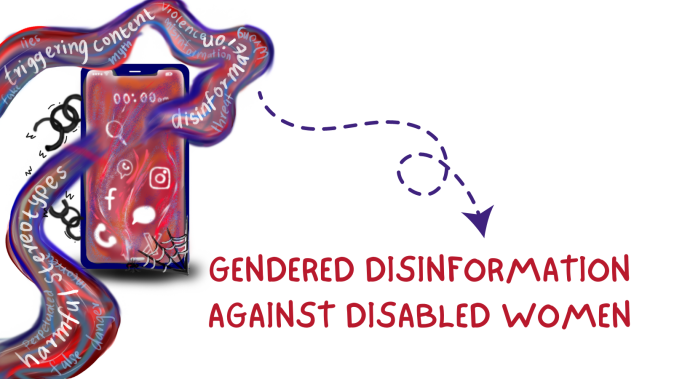When Disinformation Weaponises Disability: #DefeatDeceit

Online gender-based violence in general, and the phenomenon of gendered disinformation in particular, are not only affected by gender. They are exacerbated by all forms of hierarchy.
So what is gendered disinformation? Gendered disinformation is a strategy to silence women and queer folks that “uses false or misleading gender and sex-based narratives against women, often with some degree of coordination”, and aims to stop women and queer (human rights defenders) from taking part in digital publics.[1] It tries to undermine the credibility of women and other marginalised genders — and is worsened when affected by other inequal systems, such as ableism.
Ableism is an important concept when talking about disability and disability rights. According to accessliving.org — a leading force in the disability community, “Ableism is the discrimination of and social prejudice against people with disabilities based on the belief that typical abilities are superior. At its heart, ableism is rooted in the assumption that disabled people require ‘fixing’ and defines people by their disability. Like racism and sexism, ableism classifies entire groups of people as ‘less than,’ and includes harmful stereotypes, misconceptions, and generalizations of people with disabilities.”[2]
Disabled women and queer persons face the same range of online gender-based violence that is faced by non-disabled women and queer persons — with more targeted attacks due to their disabled identity.
Threats of violence, gendered shaming and intimidation remain major ways to attack disabled women and women human rights defenders, and gendered disinformation that also uses ableism may attack their appearance, speech, and ways of being to devalue their credibility and humanity.
False and misleading information about disabled women, which use ableist stereotypes and prejudices, may perpetuate harmful stereotypes about disabled women and women human rights defenders — portraying them as helpless, dependent, or burdensome — and thus, reduce their credibility in ways that do not apply to non-disabled women.
This is often carried out with the same aim as all gendered disinformation — to silence women human rights defenders and disabled women as active participants in democratic discourse and digital publics. Such erasure and silencing perpetuates inequalities and prevents the voices of disabled women from being heard and represented, a critical part of moving towards a more equal society.
A big part of tackling the problem of gendered disinformation (as well as overall gender-based violence) is the issue of access. Accessibility in general is hard to come by for disabled persons, be it online or offline. In the digital world, just as in the physical world, access is rarely an in-built feature. It is mostly an afterthought, and a hard-won one at that. Since most platforms aren’t accessible to most disabled persons, the entry of disabled women is either not possible in many or their interactions with the digital environment are forced to remain on the surface-level.
What happens in such a situation is: Disabled women or women human rights defenders may not even be aware of the digital violence carried out against them, and are forced to know about it from other sources — when it has already been disseminated to such a level. This is a layer of ableist violence coded into most technology that disallows women with disabilities to know it first hand, report it, respond to it or halt it in other ways.
In fact, even without gendered disinformation, as the reality of technology and tech platforms exists today, women with disabilities are not able to fully participate and express their opinions in shared digital spaces — due to levels of inaccessibility that make it all but inoperational to disabled women.
Such technology environments already play a large role in silencing disabled women, and if we add to it the problems of online gender-based violence and gendered disinformation against the few visible disabled women who navigate these platforms, we can see that the problems created by inaccessibility multiply the silencing of disabled women and women human rights defenders manifold.
The aim of eliminating gendered disinformation, and in fact — all forms of gendered violence online, is in part, to create a feminist internet that all of us can equally participate and feel safe in. If basic problems of access are left unattended to, eliminating online gender-based violence still won’t guarantee a feminist internet where all of us have the choice to be active participants.
This also means that disabled women are denied from the get go to be an agent in solving the problems that currently surround us, even when they are at the center of it — through any of the identities that they may hold: of gender, disability or other axes.
Any solution that we may want to usher in to the above problems must put access at the centre of all our discussions and actions. If we truly want to place a lens of disability rights and justice to issues of gendered disinformation, accessibility must be at the core of all our thinking — to get disabled women into digital publics and have fruitful dialogue and advocacy that puts their needs at the front and centre of future action.
When access is the core, disabled women will get greater digital autonomy — to participate in dialogue, be more visible, know about targeted attacks of gendered disinformation (or any other kind of online gender-based violence), and respond to it in whichever manner(s) they choose. Accessibility must be a feature, and not an afterthought.
- Log in to post comments
